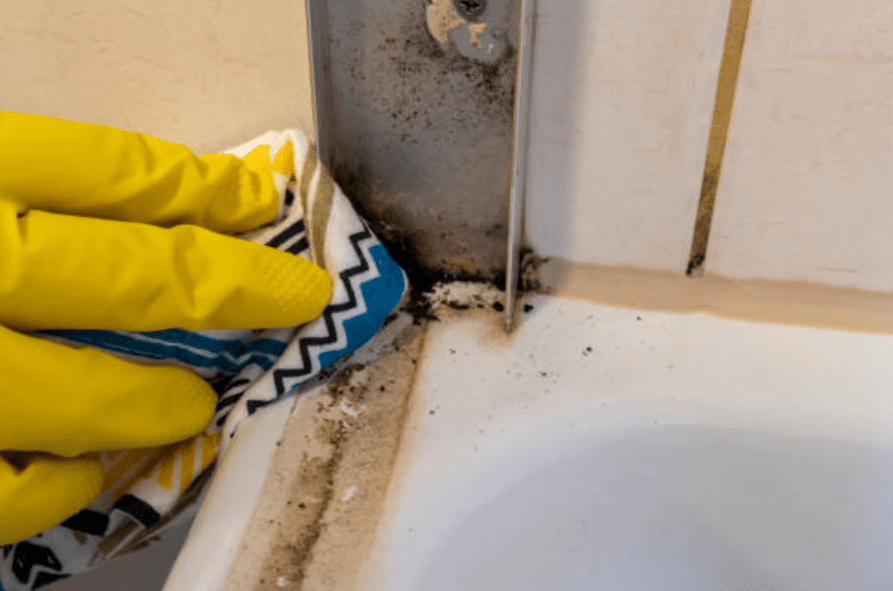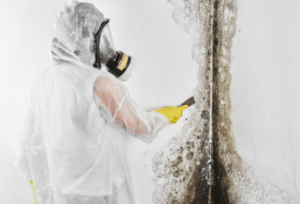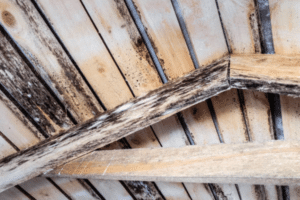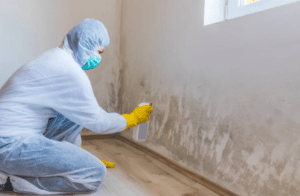Mould remediation is a complex process that requires specialised training and equipment. It has changed through the early 1900’s up to the methods in modern times.
Depending on the severity of the infestation and the type of materials affected, mould remediation companies adapts a variety of techniques to remove mould from homes and businesses.
In this blog post, we’ll explore the history of mould remediation techniques over the years.
We’ll discuss the different methods that have been used to remove mould, from the early days of simply removing the affected materials to the latest technologies that can kill mould and remove mould spores without damaging the underlying materials.
Key Takeaways
- Advancements in mould remediation techniques have improved the control and prevention of indoor mould growth.
- Excessive moisture is a common cause of mould growth and can lead to health complications and damage to buildings.
- Proper testing and remediation procedures are essential for safely removing mould and protecting indoor environments.
- Reusable containment barrier walls and portable HEPA filtration systems are key tools in the mould remediation process.
- The mould remediation industry continues to innovate and develop new solutions for maintaining safe and healthy indoor spaces.
Mould Remediation Statistics in the UK
According to a 2022 survey by the British Insurance Association, mould claims in the UK have increased by 20% in the past five years.
A 2019 study by the University of Nottingham found that current mould remediation techniques are not always effective in removing all mould spores from an environment. The study found that spores can remain in the air for up to two weeks after remediation, even when HEPA vacuuming is used.
Another study, published in the journal Indoor Air in 2020, found that mould remediation can lead to a significant reduction in the number of mould spores in the air. However, the study also found that mould spores can return to the environment within a few weeks if the source of moisture is not repaired.
History of Mould Remediation
The history of mould remediation can be traced back to the early 1900s, when scientists first began to study the effects of mould on human health.
At the time, the most common method of mould remediation was to simply remove the affected materials, such as drywall or insulation. This method was effective, but it was also very expensive and time-consuming.
In the 1970s, scientists developed new mould remediation techniques that were more effective and less expensive.
These techniques included using chemical biocides to kill the mould and using HEPA filters to remove mould spores from the air.
In the 1980s and 1990s, mould remediation became even more sophisticated. Scientists developed new techniques, such as thermal remediation and dry ice blasting, which could kill mould and remove mould spores without damaging the underlying materials.
Understanding Mould Growth and Its Effects
Before delving into the history of mould remediation techniques, it is crucial to understand the factors that contribute to mould growth and its detrimental effects.
Excessive moisture, whether from leaks, floods, or poor ventilation, creates the perfect breeding ground for mould.
In as little as 24 hours, mould can begin to grow on various surfaces, including walls, ceilings, and furniture. This rapid growth highlights the urgency of implementing effective mould growth prevention measures.
Mould not only poses a threat to the structural integrity of buildings but also has significant health implications.
Prolonged exposure to mould spores can trigger respiratory problems, allergic reactions, and even worsen existing conditions such as asthma.
Moreover, mould can cause damage to building materials, leading to decay, discolouration, and unpleasant odours.
To address these issues, the mould remediation industry aims to restore indoor environments to a safe and healthy state.
Proper testing and assessment procedures are vital to determine the extent of mould growth and identify the affected areas.
Once identified, these areas can be safely contained and the mould removed using specialised equipment and techniques.
| Mould Growth Prevention | Mould Damage Restoration | Mould Remediation Industry |
|---|---|---|
| Implement measures to control moisture levels and prevent excessive condensation. | Restore affected areas by removing mould-infested materials, treating surfaces, and implementing preventive measures. | Industry professionals utilise advanced techniques, equipment, and expertise to provide effective mould remediation services. |
| Regularly inspect and maintain HVAC systems to ensure proper ventilation and prevent moisture buildup. | Address water leaks, fix plumbing issues, and improve drainage systems to prevent further water damage and mould growth. | Efforts are focused on developing innovative solutions and improving remediation techniques to ensure safe and healthy indoor environments. |
Early Mould Remediation Methods
In the early days of mould remediation, efforts were focused on manual cleaning and basic prevention measures to tackle the growing mould problem.
The understanding of mould and its impact on health and buildings was limited, leading to primitive approaches to combat the issue.
Cleaning affected areas with soap, water, and bleach was commonly practiced, but this method only addressed surface mould and did not effectively remove the root cause of the problem.
Basic prevention measures included improving ventilation, addressing moisture sources, and implementing humidity control.
These methods aimed to reduce the conditions that promote mould growth, but they were not always successful in preventing the recurrence of mould.
Without proper inspection and assessment of affected areas, mould could easily spread and reappear, causing further damage to buildings and risking occupants’ health.
Early Mould Remediation Techniques
As our understanding of mould grew, so did the need for more advanced mould remediation techniques.
The development of specialised tools and equipment played a crucial role in improving the effectiveness of remediation efforts.
For instance, the introduction of high-powered vacuums with HEPA filters enabled the removal of mould spores and other airborne particulates, reducing the risk of cross-contamination and promoting better indoor air quality.
Additionally, the use of containment barrier walls became a standard practice to isolate affected areas during the remediation process.
These reusable barriers prevent the spread of mould spores and ensure that the remediation efforts are concentrated in a controlled environment.
Portable HEPA filtration systems were also incorporated into the process to capture and remove harmful airborne particulates, further reducing the risk of exposure to mould.
| Mould Remediation Methods | Advantages | Disadvantages |
|---|---|---|
| Manual Cleaning with Soap and Water | Cost-effective | Ineffective for deep-seated mould |
| Bleach Treatment | Kills surface mould | Does not address root cause |
| Improving Ventilation | Reduces moisture levels | May not eliminate mould completely |
| Containment Barrier Walls | Prevents cross-contamination | Requires professional installation |
| Portable HEPA Filtration Systems | Removes airborne particulates | Additional cost and maintenance |
It is important to note that early mould remediation methods, although limited in their effectiveness, laid the foundation for the advancements we have today.
The lessons learned from these early techniques paved the way for the development of more sophisticated and targeted approaches.
Over the years, the mould remediation industry has made significant progress in improving techniques and procedures to combat mould growth and maintain safe and healthy indoor environments.
Advancements in Mould Remediation Technology
As awareness about the health hazards associated with mould exposure grew, so did the need for advanced mould remediation techniques, resulting in significant technological advancements.
The mould remediation industry has made remarkable progress in developing innovative solutions to effectively control and eliminate mould growth in indoor environments.
One of the key advancements in mould remediation is the introduction of reusable containment barrier walls.
These walls are made of durable materials and can be easily assembled to create a sealed area, isolating the affected space from the rest of the building.
By preventing the spread of mould spores, these barriers allow for targeted remediation and minimise the risk of cross-contamination.
Portable HEPA (High-Efficiency Particulate Air) filtration systems are another important tool in modern mould remediation.
These compact devices are designed to effectively capture and remove airborne mould spores, allergens, and other contaminants.
Equipped with powerful filters, HEPA filtration systems ensure that the air in the affected area is thoroughly cleaned, providing a safer environment for both the occupants and the remediation professionals.
Innovative Techniques for Mould Mitigation
“The use of infrared cameras and moisture meters has revolutionised the way we detect and assess mould growth,” says John Smith, a certified mould specialist. “These advanced tools allow us to identify hidden sources of moisture, which are essential for effective mould mitigation.”
Infrared (IR) cameras are now widely used in the mould remediation industry to locate areas of moisture intrusion.
By detecting temperature differences, these cameras can pinpoint potential sources of mould growth behind walls, under floors, and in other inaccessible areas.
This non-invasive method enables professionals to accurately assess the extent of mould damage and devise appropriate remediation strategies.
Moisture meters, on the other hand, provide quantitative measurements of moisture content in various building materials.
By gauging the moisture levels, experts can determine the severity of the moisture problem and guide the remediation process accordingly.
These precise measurements help prevent unnecessary removal of unaffected materials, minimising costs and reducing disruption during the remediation process.
Overall, the continual advancement of mould remediation technology has revolutionised the industry, enabling professionals to address mould growth more effectively and efficiently.
By implementing these modern techniques and utilising state-of-the-art equipment, mould remediation specialists can ensure the safety and well-being of occupants while restoring and maintaining a healthy indoor environment.
Key Tools and Equipment in Mould Remediation
The mould remediation process relies on a range of specialised tools and equipment designed to effectively remove mould and prevent its recurrence.
With the understanding that mould growth can pose significant health risks and cause damage to building materials, it is crucial to have the right tools for the job.
These tools not only aid in the containment and removal of mould but also ensure the safety of both the remediation professionals and the occupants of the affected space.
One essential tool used in mould remediation is the reusable containment barrier wall. This barrier is deployed to isolate the affected area from the rest of the building, preventing the spread of mould spores to unaffected areas.
Made from durable materials, the containment barrier creates a physical barrier that helps to control the airflow and limit cross-contamination.
In addition to containment barriers, portable HEPA (High-Efficiency Particulate Air) filtration systems play a crucial role in the mould removal process.
These systems are equipped with filters that can trap and remove tiny airborne particles, including mould spores.
By utilising HEPA filtration, the equipment ensures that the air within the containment area remains clean and free from harmful particulates.
| Key Tools and Equipment | Function |
|---|---|
| Reusable Containment Barrier Walls | Create a physical barrier to isolate the affected area and prevent cross-contamination |
| Portable HEPA Filtration Systems | Remove airborne mould spores and maintain clean air within the containment area |
| Moisture Meters | Measure the moisture content of materials to identify potential mould growth areas |
| Personal Protective Equipment (PPE) | Ensure the safety of remediation professionals by providing respiratory masks, gloves, and coveralls |
Another critical component of mould remediation is the use of moisture meters. These devices help assess the moisture content of materials, allowing professionals to identify areas prone to mould growth.
By pinpointing these moisture sources, remediation efforts can be targeted more effectively, preventing the recurrence of mould in the future.
Furthermore, personal protective equipment (PPE) is essential in ensuring the safety of remediation professionals.
Respiratory masks, gloves, and coveralls protect against exposure to mould spores and other contaminants during the remediation process.
The proper use of PPE minimises the risks associated with mould remediation and ensures a safe working environment for the professionals involved.
The Role of Professionals in Mould Remediation
When faced with a mould infestation, it is crucial to enlist the help of mould removal specialists to ensure the effective and safe removal of mould from your home.
These professionals have the necessary expertise and equipment to assess the extent of the mould growth and implement appropriate remediation procedures.
Mould removal specialists, also known as mould remediation experts, are highly trained in identifying the underlying causes of mould growth and implementing effective solutions to eliminate it.
They use specialised tools and techniques to evaluate the moisture levels, identify the type of mould present, and assess the damage it may have caused to your property.
One of the key tools used by mould removal specialists is reusable containment barrier walls. These walls help isolate the affected areas, preventing the spread of mould spores to unaffected parts of your home.
Additionally, portable HEPA (High-Efficiency Particulate Air) filtration systems are employed to capture and remove harmful airborne particulates, ensuring that the air in your home remains clean and safe.
Why Choose Professional Mould Removal Services in London
Mould removal specialists in London are well-versed in the specific challenges faced by homeowners in the city.
They understand the local climate, which can contribute to moisture issues and mould growth, and have extensive experience in dealing with various types of mould infestations.
By hiring a professional mould removal service in London, you can be confident that the remediation process will be carried out efficiently and effectively.
These experts follow industry best practices and use advanced techniques to not only remove the existing mould but also prevent its recurrence.
Remember, mould growth can have serious consequences for your health and the structural integrity of your home.
By entrusting the task of mould removal to professionals, you can ensure a thorough and safe remediation process, protecting both your property and your well-being.
| Benefits of Professional Mould Cleaning Services |
|---|
| Expert assessment and identification of mould growth |
| Safe and effective removal of mould |
| Prevention of mould recurrence |
| Protection of your health and property |
The Ongoing Development of Mould Remediation Techniques
The mould remediation industry is constantly evolving, with experts dedicating their efforts to refining techniques and developing new solutions for safely and effectively removing mould.
Advances in technology and increased awareness of the health risks associated with mould growth have driven the need for more efficient and comprehensive remediation methods.
One of the key areas of focus in the industry is the development of innovative tools and equipment that aid in the containment and removal of mould.
Professionals now have access to reusable containment barrier walls and portable HEPA filtration systems, which play a crucial role in preventing the spread of mould spores and harmful airborne particulates during the remediation process.
These advancements not only improve the safety of the workers but also ensure a more thorough and effective removal of mould from affected areas.
In addition to technological advancements, ongoing research and collaboration within the mould remediation industry have led to the formulation of more specialised and targeted approaches.
Mould experts have developed detailed protocols for assessing the extent of mould growth, identifying the underlying causes, and implementing appropriate remediation procedures.
These protocols take into account the unique characteristics of different types of mould and provide guidelines for the safe removal of affected materials.
Continued Innovation for a Safer Environment
The continuous development of mould remediation techniques is driven by the shared goal of creating safer indoor environments.
Experts are constantly exploring new methods and materials to improve the efficiency and effectiveness of mould removal.
This allows for quicker response times and better restoration outcomes, minimising the potential damage to building materials and reducing health risks for occupants.
With the ongoing commitment to research, training, and collaboration, the mould remediation industry is well-equipped to address the challenges posed by mould growth.
By staying up-to-date with the latest advancements and engaging in continuous improvement, mould specialists are at the forefront of promoting healthier living and working spaces.
| Advancements in Mould Remediation Techniques | Key Tools and Equipment in Mould Remediation |
|---|---|
| Reusable containment barrier walls | Mould removal process |
| Portable HEPA filtration systems | Mould removal procedures |
| Specialised assessment protocols | Mould remediation industry |
Conclusion
The history of mould remediation techniques highlights the significant advancements made in controlling mould growth, emphasising the crucial role of professional mould damage restoration services in maintaining a safe and healthy indoor environment.
Excessive moisture, caused by leaks, floods, or poor ventilation, can lead to mould growth in as little as 24 hours. The harmful effects of exposure to mould include health complications and damage to building materials.
To properly address mould issues, it is essential to conduct thorough testing and assessment to determine the extent of mould growth.
This allows for the development of effective remediation procedures that safely remove affected materials and prevent further damage.
Key tools in the mould remediation process include reusable containment barrier walls and portable HEPA filtration systems.
These tools help to contain affected areas, preventing the spread of mould spores and harmful airborne particulates.
By using these technologies, professionals can ensure the safe removal of mould and restore a healthy indoor environment.
As the mould remediation industry continues to evolve, professionals are constantly working on innovative solutions to improve techniques and maintain safe and healthy indoor environments.
By staying up to date with the latest advancements, mould specialists are able to provide effective services that protect both your health and property.
FAQ
Q: Is there a history of mould remediation techniques?
A: Yes, there is a history of mould remediation techniques. The earliest recorded methods involved physical removal of mouldy materials, such as burning or burying them.
Over time, people began to develop more sophisticated methods, such as using chemicals to kill mould or environmental controls to prevent mould growth.
Today, mould remediation professionals use a combination of these techniques to remove mould safely and effectively.
Q: What are the harmful effects of exposure to mould?
A: Exposure to mould can lead to health complications and damage to building materials.
Q: How quickly can mould grow in indoor spaces?
A: Excessive moisture caused by leaks, floods, or poor ventilation can lead to mould growth in as little as 24 hours.
Q: What are the key tools for mould remediation?
A: Key tools include reusable containment barrier walls and portable HEPA filtration systems to contain affected areas and remove harmful airborne particulates.
Q: What does proper testing and remediation involve?
A: Proper testing and remediation procedures involve assessing the extent of mould growth and safely removing affected materials.
Q: What is the purpose of mould remediation?
A: Mould remediation aims to control, contain, and remove indoor mould growth to maintain safe and healthy indoor environments.
Mould remediation techniques have evolved over the years, and professional mould remediators have the latest tools and expertise to remove mould safely and effectively.
Don’t attempt to remove mould yourself as you may spread the mould spores even more. Professional mould remediators know how to remove mould without spreading the spores.
If you have mould in your home or business, call us today at 0203 130 4068.





